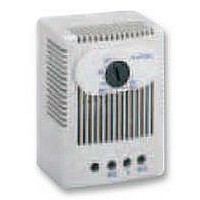NSYCCOHY230VID SCHNEIDER, NSYCCOHY230VID Datasheet - Page 58

NSYCCOHY230VID
Manufacturer Part Number
NSYCCOHY230VID
Description
HYGROSTAT, CO, 35-95% RH
Manufacturer
SCHNEIDER
Datasheet
1.NSYCCOHY230VID.pdf
(68 pages)
Specifications of NSYCCOHY230VID
Body Colour
Light Grey
External Width - Metric
33mm
Body Material
Plastic
Colour
Light Grey
External Width
33mm
Ip/nema Rating
IP20
Operating Temperature Max
60°C
Operating
RoHS Compliant
Enclosure Material
Thermoplastic
Rohs Compliant
Yes
Accuracy
± 4%
Accuracy %
4%
Airflow
15 M/seg
Contact Configuration
CO
Capacitance
0µF
Thermal balance
ClimaSys
Thermal management system
Ventilation
Circulation
Air circulation inside the enclosure with the help of a fan helps ensure an even
temperature, avoiding hot spots that can damage certain components.
Forced ventilation
Fans are designed to evacuate a considerable amount of heat coming from the
components of the electrical switchboards. The service life of the switchboard is
considerably extended, helping to ensure the long life and correct operation of the
installation.
Fans can only be used if the ambient temperature is at least 5 ºC lower than the
desired temperature inside the enclosure.
They offer an efficient solution to the problem of temperature increases in the
electrical switchboards; one that is inexpensive and easy to implement and
maintain. Thanks to their standard IP54 degree of protection (IP55 with accessories)
the fans are suitable for use in industrial and tertiary sectors.
Heating
Resistance heaters
Resistance heaters can be used for two reasons:
● To reheat the electrical switchboard when the ambient temperature is too low for
the correct operation of the components.
● To prevent the formation of condensation.
The second phenomenon can cause short-circuits, premature oxidation of the
contacts, corrosion of metal parts and the enclosure, and a considerable reduction
in the service life of the electrical and electronic components.
Condensation occurs when the temperature suddenly drops below the dew point
temperature. To avoid this, it is necessary to maintain the temperature inside the
enclosure at a few degrees above the ambient temperature of the environment.
Thanks to their design, the heaters encourage natural convection and help ensure
quick and even heating within the enclosure.
7
7/58










